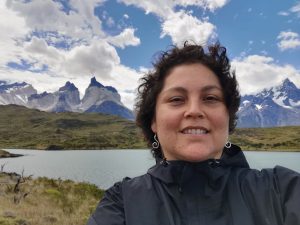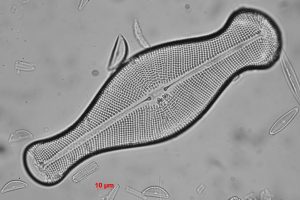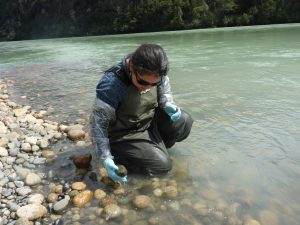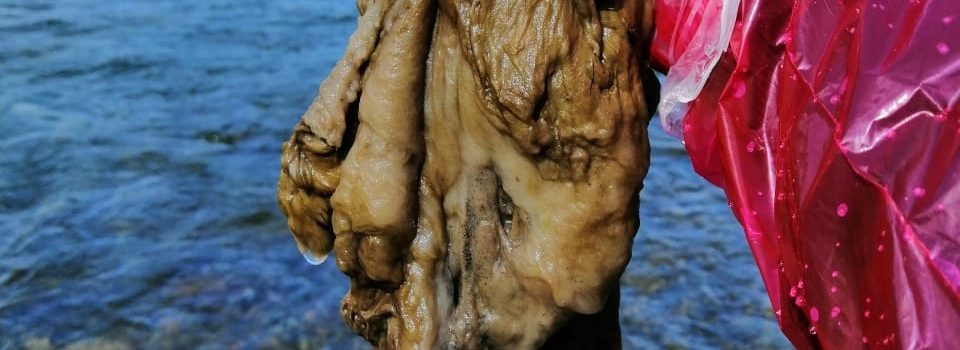Didymo the invasive microalgae that is here to stay
May 13th, 2021 Today, Friday May 7th, webinar “Invasive Exotic Species: from a comprehensive view” is held, organized by Sernapesca, in which Dr. Alejandra Oyanedel, from the Fisheries Development Institute (IFOP) participates with the talk Didymo la microalga invader that is here to stay.
Today, Friday May 7th, webinar “Invasive Exotic Species: from a comprehensive view” is held, organized by Sernapesca, in which Dr. Alejandra Oyanedel, from the Fisheries Development Institute (IFOP) participates with the talk Didymo la microalga invader that is here to stay.
Dr. Oyanedel explained “Didymosphenia geminata, commonly called ‘didymo’ or ‘rock mucus’, is an invasive exotic microalgae that proliferates rapidly and develops massive blooms in rivers and lakes that have a low nutrient load. In this way, this microalgae can affect large areas of the aquatic habitat through the formation of a dense cover of yellowish brown or whitish color, cottony in appearance and resistant to the touch, which strongly alters trophic webs, reproduction in fish, value aesthetic of the landscape, impoverishing freshwater diversity on a local and regional scale, thus constituting an environmental problem that requires attention.
 Didymo was recorded for the first time in 2010 in a river system in southern Chile. After its detection, it was declared a pest species by the Undersecretary of Fisheries and Aquaculture in attention to the S.D. (MINECON) N ° 345 of 2005. Since then, a constant prospecting and monitoring activity has been maintained, in addition to various dissemination campaigns aimed at preventing the spread of the plague to new bodies of water. Since the end of 2016, Fishing Development Institute (IFOP) executes a program called ” Plague species Didymosphenia geminata monitoring in water bodies of central, southern and southern Chile” that allows knowing updated geographical distribution of this invasive microalgae, the effects on other biological components and allows to investigate its relationship with environmental variables at different spatial scales ”.
Didymo was recorded for the first time in 2010 in a river system in southern Chile. After its detection, it was declared a pest species by the Undersecretary of Fisheries and Aquaculture in attention to the S.D. (MINECON) N ° 345 of 2005. Since then, a constant prospecting and monitoring activity has been maintained, in addition to various dissemination campaigns aimed at preventing the spread of the plague to new bodies of water. Since the end of 2016, Fishing Development Institute (IFOP) executes a program called ” Plague species Didymosphenia geminata monitoring in water bodies of central, southern and southern Chile” that allows knowing updated geographical distribution of this invasive microalgae, the effects on other biological components and allows to investigate its relationship with environmental variables at different spatial scales ”.
“IFOP’s monitoring is based on samplings carried out twice a year, covering rivers and lakes located between the Maule and Magallanes regions. Part of the findings on the presence of Didymo were included in Exempt Resolution No. 719/2021 (SUBPESCA) which reports 109 subsubbasins in the Plague category (ie with the presence of didymo in benthos) and 18 subsubbasins in the Plague Risk category. (ie with the presence of didymo in the water column). In addition, based on the most up-to-date information generated by IFOP, which will be included in the next Pest Areas Declaration, it shows that didymo is found in 24 new sub-basins, adding a total of 151 sub-basins in the country that present this pest, the which are located along a latitudinal range of approximately 2000 km, where there is great environmental variability, different degrees of anthropogenic disturbances, and also affecting some units of the State Protected Areas System ”, explained the IFOP professional.

“Given this species current distribution, its potential to invade new aquatic systems and that it is a pest, the actions that tend to prevent its dispersal become relevant. All the people who use the water for the development of recreation, research, productive and subsistence activities, must apply basic biosecurity measures: remove, wash and dry, indicated by SERNAPESCA. Especially if people have the ability to move to different systems, distant and in a short time. Additionally, it is advisable to use PVC wading boots without textile non-stick as they allow efficient washing with chlorinated solutions and rapid drying, simultaneously preventing the didymo cells from being lodged in the fibers and being transported to other pest-free systems. It is also recommended to use a commercial detergent and bleach solution, rigid plastic brushes for washing, and to rinse all implements with clean water. Finally, people are urged to consult which rivers and lakes are contained in the declarations of plague areas, to observe their surroundings and to report the presence of this plague, ”explained Oyanedel.
